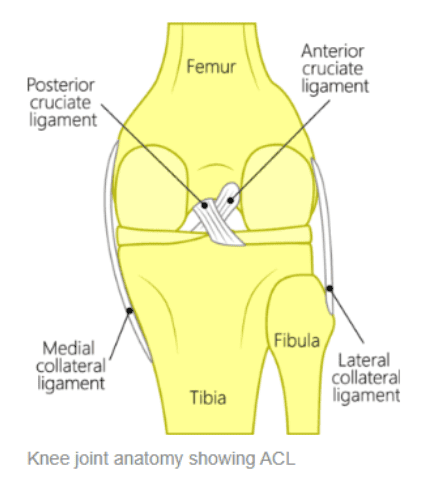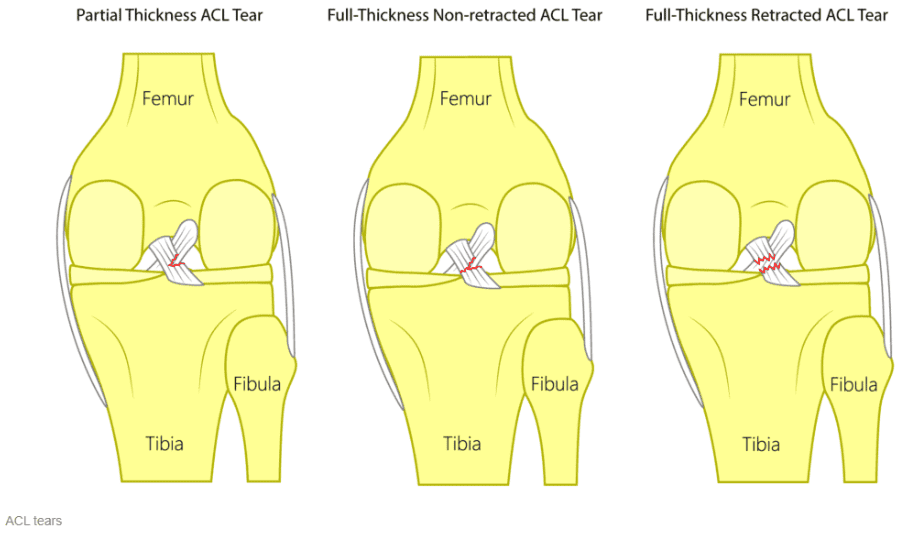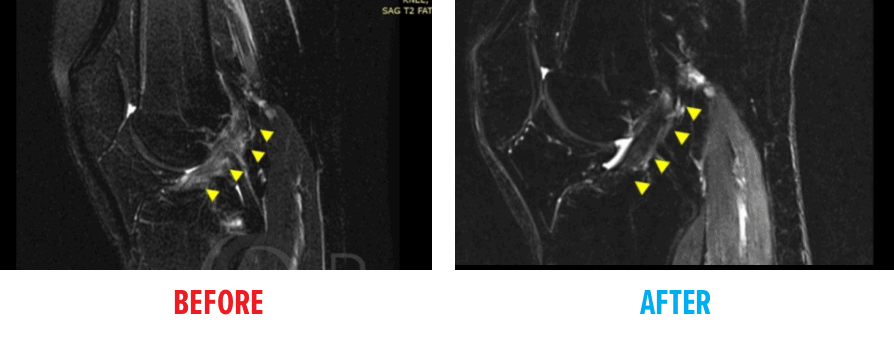Understanding ACL Tear: Why It Happens And What To Do Next
- Anatomy And Function Of Anterior Cruciate Ligament (ACL) ↓
- What Does A Tear In The ACL Mean? ↓
- Types Of ACL Tears ↓
- Common Triggers For Knee Ligament Problems ↓
- How To Recognize The Symptoms Of Ligament Damage ↓
- Avoid Complications Through Prompt Medical Attention ↓
- Diagnosing Torn ACL ↓
- Treatment Options For ACL Tear ↓
- Surgery Isn’t Always The Best Option And Here’s Why ↓
- Regenexx Offers Non-Surgical Treatment For ACL Tears ↓
- Perc-ACLR: Redefining Non-Surgical Ligament Care ↓
- Explore Different Options For Managing Your Knee Condition ↓
- Get started to see if you are a Regenexx candidate ↓

Medically Reviewed By:
An anterior cruciate ligament (ACL) tear is a common knee injury, particularly among athletes. Studies estimate there are between 100,000 and 200,000 cases of ACL tears annually in the United States. This injury occurs when the ligament, which is key to stabilizing the knee joint, is overstretched or torn.
ACL tears can result in knee instability, affecting mobility and athletic performance. Gaining a clear understanding of the causes, symptoms, and treatment options is critical to effectively managing the injury and preserving joint function.
Anatomy And Function Of Anterior Cruciate Ligament (ACL)
The ACL is one of two cruciate ligaments within the knee joint. These ligaments intersect, creating an “X” shape, with the ACL positioned at the front and the posterior cruciate ligament (PCL) at the back.
The ACL supports knee stability by helping to prevent the tibia (shinbone) from moving too far forward relative to the femur (thighbone). The PCL complements this function by limiting excessive backward movement of the tibia. Together, these ligaments help maintain proper knee alignment and support controlled movement.

What Does A Tear In The ACL Mean?
An ACL tear is a significant knee injury that can affect stability, mobility, and overall function. Because the ACL plays a key role in controlling knee movement, a tear may lead to pain, swelling, and a feeling of instability. Activities that involve running, jumping, or pivoting can become challenging. In some cases, the knee may give way during movement.
Types Of ACL Tears
ACL tears vary in severity and are classified based on the extent of the damage:
- Partial-thickness ACL tear: A partial tear damages the ligament but does not fully rupture it. Imaging shows some intact fibers, and knee stability may be compromised.
- Full-thickness non-retracted ACL tear: A complete tear severs the ligament, but the ends remain aligned and do not pull apart. Some knee stability may remain.
- Full-thickness retracted ACL tear: A full tear completely separates the ligament, causing the ends to retract. This often leads to significant knee instability and impaired function.

Common Triggers For Knee Ligament Problems
Several factors contribute to ACL tears, often involving movements that place excessive stress on the knee. Understanding these triggers can help reduce injury risk. Common causes include:
Sudden Turns While Feet Remain Stationary
A leading cause of ACL tears occurs when an athlete pivots suddenly while their feet stay planted. This abrupt motion places excessive strain on the ligament, increasing the risk of injury. Sports like soccer, basketball, and football often involve rapid direction changes, making athletes more vulnerable to this type of stress on the knee.
Falls
ACL tears can occur when a fall involves a twisting motion or a direct impact to the knee. The sudden force may overstretch or rupture the ligament. This is especially common in sports like skiing, where falls are frequent, and in accidents that cause abrupt shifts in body weight and balance.
Hyperextended Knee
A hyperextended knee occurs when the joint is forced beyond its normal range of motion, causing the ACL to overstretch or tear. This often happens during running or jumping, especially if the knee is pushed backward upon landing. Hyperextension places significant stress on the ligament, increasing the risk of injury.
Direct Blows To The Outer Knee
A direct impact to the outer knee, common in contact sports like rugby or football, can put excessive stress on the ACL. This force may destabilize the joint, increasing the risk of a tear. Such injuries often occur during tackles or when the knee is struck by another player or object.
How To Recognize The Symptoms Of Ligament Damage
Recognizing ACL tear symptoms is essential for early intervention. Common signs include:
- Audible popping or grating sounds: A sudden pop or grating noise at the time of injury, often signaling ligament damage.
- Swelling or inflammation: Rapid swelling around the knee, typically developing within hours.
- Pain during movement: Discomfort that worsens with weight-bearing or knee movement.
- Weakness or instability: A feeling of the knee giving way, making movement difficult.
- Restricted range of motion: Difficulty bending or straightening the knee due to pain or swelling.
Avoid Complications Through Prompt Medical Attention
Seeking timely medical evaluation for an ACL tear is essential for proper diagnosis and management. A thorough assessment by a physician can help determine the extent of the injury and reduce the risk of further damage.
If left untreated, an ACL tear may lead to complications such as:
- Chronic knee instability: Ongoing instability increases the risk of further knee injuries.
- Osteoarthritis: Repeated joint instability can contribute to early-onset osteoarthritis, leading to pain and stiffness.
- Meniscus damage: A torn ACL may also lead to meniscus injuries, further affecting knee function.
- Reduced mobility: Untreated ACL injuries can limit the range of motion, impacting daily activities and athletic performance.
Diagnosing Torn ACL
Accurately diagnosing an ACL tear requires a combination of physical examination and advanced imaging. Physicians typically begin with a medical history review and physical tests to assess knee stability.
Standard diagnostic methods include:
- Physical exam: Tests like the Lachman test or anterior drawer test help evaluate knee stability.
- X-rays: X-rays are used to rule out fractures, though they do not show ligament damage.
- MRI (magnetic resonance imaging): MRI provides detailed images of soft tissues, making it the most accurate tool for diagnosing ACL tears.
- Arthroscopy: This is a minimally invasive procedure that uses a tiny camera inside the knee to confirm ligament damage.
Treatment Options For ACL Tear
Managing an ACL tear involves various treatment options to support knee function and recovery. The best approach depends on the severity of the tear and the individual’s activity level.
- RICE method: The RICE method—rest, ice, compression, and elevation—helps reduce swelling but can slow healing, cause stiff joints, and lead to ice burns if overused.
- Physical therapy: Strengthening exercises improve flexibility, restore motion, and help prevent future injuries.
- Assistivedevices: Knee braces or crutches provide support and minimize stress on the knee during healing.
Surgery Isn’t Always The Best Option And Here’s Why
Surgery is not always necessary for ACL injuries, and outcomes vary. Research shows that only about half of athletes who undergo ACL reconstruction regain full function and return to sports at the same level. While surgery can restore knee stability, it may not fully replicate natural biomechanics or proprioception. Surgical intervention carries potential complications, including:
- Approximately 17% of adults will experience anterior knee pain or pain when kneeling.
- Between 5% and 29% will experience graft failure and loss of knee joint stability, with higher rates in younger patients.
- Other potential complications include:
- Knee stiffness or loss of range of motion (approximately 5%)
- Painful hardware (approximately 6%)
- Infection (approximately 1% to 2%)
- Patellar tendon rupture or patellar fracture in the case of bone-to-bone grafts.
- Knee stiffness or loss of range of motion (approximately 5%)
- Increased youth participation in high-intensity sports has led to more ACL surgeries, but research suggests complications may be worse in teens.
- A study of 160 clinical trials found higher post-surgery complications in young teens, with increased risks of growth disturbances, skeletal deformities, and ligament re-rupture requiring a second surgery.
- A 2010 Swedish study showed that 60% of athletes (average age = 26) who chose physical therapy over surgery didn’t need ACL replacement and could still play sports.
Regenexx Offers Non-Surgical Treatment For ACL Tears
Regenexx provides a non-surgical option for ACL injuries through interventional orthobiologics. Physicians in the licensed Regenexx network use ultrasound guidance to precisely inject bone marrow concentrate, processed with Regenexx lab protocols, into the affected area.
The cellular components in bone marrow concentrate support the body’s natural healing response, helping to maintain knee stability and function. This approach offers an alternative to surgery, potentially reducing downtime and reliance on medications. Individual results may vary.
Perc-ACLR: Redefining Non-Surgical Ligament Care
Perc-ACLR (percutaneous ACL repair) is an advanced approach developed by physicians in the licensed Regenexx network to address partial and select full-thickness non-retracted ACL tears without surgery. ACL injuries are among the most common knee issues, and this technique provides a minimally invasive alternative for many cases.
This innovative procedure uses precise image guidance to deliver orthobiologic injectates processed with Regenexx lab protocols, supporting the body’s natural healing response. By avoiding traditional surgery, Perc-ACLR may help patients maintain knee stability and function with fewer risks and less downtime.
Research shows that ACL sprains and select non-retracted ACL tears can improve over time, especially with interventional orthobiologic procedures like Perc-ACLR. These advanced techniques activate the body’s natural healing response, offering a non-surgical alternative for many individuals.
Since the body can repair certain ACL injuries, surgery may not always be necessary. Physicians in the licensed Regenexx network typically complete the Perc-ACLR procedure in a single day.
- A Regenexx network physician extracts bone marrow using imaging guidance and a specialized Regenexx technique.
- The marrow is processed using Regenexx lab protocols while the patient rests for three to six hours.
- Local anesthesia is applied before reinjection to enhance comfort and minimize pain.
- Fluoroscopy, MRI, and X-ray contrast help guide precise injection into the damaged ligament.
Patients may experience mild soreness for one to three days, with discomfort usually decreasing within five to seven days. Most individuals notice improvement within a month and can begin light activities and physical therapy.
Recovery Time Without Surgery
When considering recovery options, it’s important to evaluate the best approach for long-term knee health and a return to activity. At Regenexx, the focus is on preserving the ACL rather than replacing it. Research and clinical experience suggest that certain ACL injuries may improve through interventional orthobiologic techniques.
The Perc-ACLR procedure is a highly precise, X-ray-guided injection of a patient’s own bone marrow concentrate, completed in a single day. This approach is significantly less invasive than surgery. It typically involves shorter recovery times, potentially allowing for a faster return to activity. Individual results may vary.
| Perc-ACLR | Surgery | |
|---|---|---|
| Procedure Invasiveness | Much less | Much more |
| Return to Sports | 3 to 6 months | 1 year |
| Keep your ACL | Yes | NO |
| Recovery | Brace, much less extensive PT | Crutches, brace, extensive PT |
BEFORE And AFTER Procedure MRI Images
The before and after images show the outcomes of patients who opted for a procedure instead of ACL surgery.


In the before image, the ACL appears visibly torn. The after image shows a dark band running diagonally, suggesting structural changes in the ligament following the procedure. This comparison illustrates how non-surgical approaches may support the body’s natural healing response.
Explore Different Options For Managing Your Knee Condition
Surgery is not the only option for managing an ACL injury. Regenexx offers non-surgical solutions, such as Perc-ACLR, which use advanced interventional orthobiologic techniques to support the body’s natural healing response. These minimally invasive treatments may provide an alternative to surgery, potentially reducing downtime.
Consulting with a healthcare professional is essential to determine the most appropriate treatment plan. Exploring Regenexx’s innovative options can help individuals take a proactive approach to maintaining knee function and long-term mobility.
Get started to see if you are a Regenexx candidate
To talk one-on-one with one of our team members about how Regenexx may be able to help your orthopedic pain or injury, please complete the form below and we will be in touch with you within the next business day.

Medically Reviewed By:
